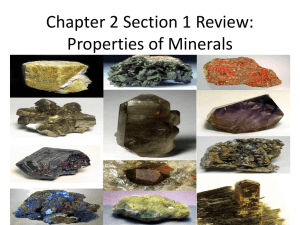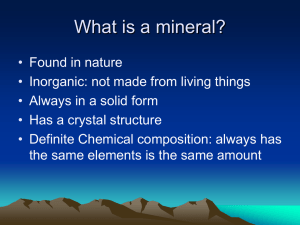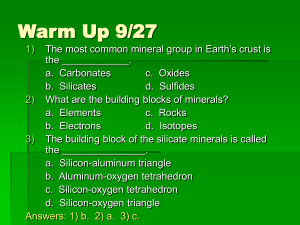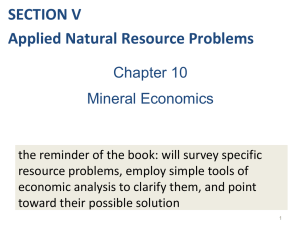Chapter 4: Minerals
advertisement
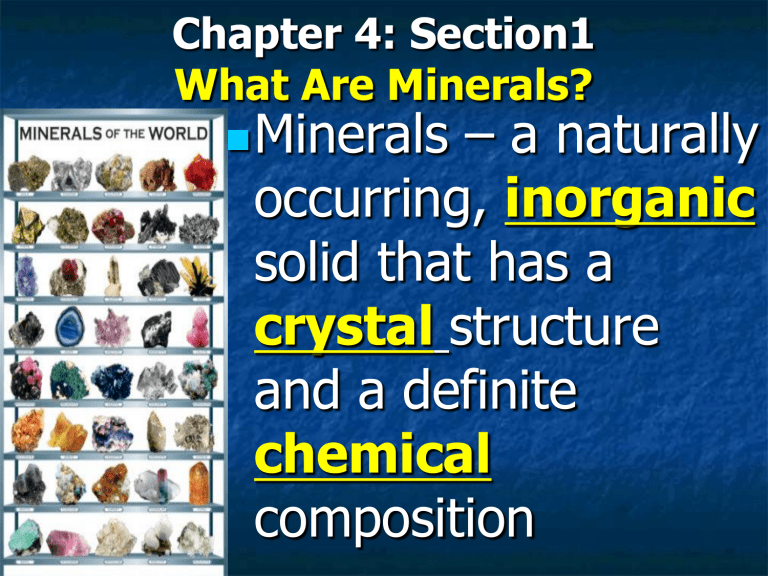
Chapter 4: Section1 What Are Minerals? Minerals – a naturally occurring, inorganic solid that has a crystal structure and a definite chemical composition What 5 Characteristics Does a Mineral Have to Have? A mineral must be: Naturally Occurring Inorganic Solid Crystal Structure Definite Chemical Composition What Does It Mean to Be Naturally Occurring? A mineral must occur naturally Cement, brick, steel, and glass all come from substances found in Earth’s crust but they are manufactured by people How Can Something Be Inorganic? Inorganic – the mineral cannot arise from materials that were once part of a living thing Ex. Coal is NOT a mineral because it is made up the remains of plants and animals What kind of pattern must a mineral have? A mineral must have a crystal structure – a repeating pattern of a mineral’s particles that forms a solid. Faces – a crystal’s flat side that meets at sharp edges and corners A What kind of composition must a mineral have? mineral must have a definite chemical composition – it always contains certain elements in definite proportions; most minerals are compounds Cinnabar – composed of the elements Mercury and Sulfur What Is the Difference Between an Element and a Compound? Element – a substance composed of a single kind of atom. Ex. Hydrogen Two or more elements combined so that the Compound – elements no longer have distinct properties Ex. Water H20 How Do You Identify Minerals? Properties: Density Crystal Shape Cleavage and Fracture Special Properties Hardness Color (this can vary) Streak Luster How Do You Determine a Mineral’s Hardness? Friedrich Mohs invented a test to describe and compare the hardness of minerals Mohs Hardness Scale Ranks ten minerals from softest to hardest How Does the Mohs Scale Work? Gypsum (2) will scratch talc (1), calcite (3) will scratch gypsum (2), fluorite (4) will scratch calcite (3), etc. What Is a Streak Test? The streak of a mineral is the color of its powder The streak color and the mineral color are often different To test: rub a mineral against an unglazed tile (streak plate) What is the Luster of a mineral? Luster – used to describe how a mineral reflects light from its surface Minerals containing metals are often shiny Earthy, waxy, and pearly What does Density have to do with Minerals? Each mineral has a characteristic Density Density – or mass per unit volume; Density = mass/volume Displacement – the volume of the displaced water equals the volume of the the sample What Kind of Shape does a Mineral have? Minerals have a crystal structure Cubic Hexagonal Tetragonal Orthorhombic Monoclinic Triclinic What is Mineral Cleavage? Cleavage – A mineral’s ability to split easily along a flat surface The ability to break apart depends on the arrangement of the atoms in the mineral Cubic Cleavage Basal Cleavage What is Mineral Fracture? Fracture – How a mineral looks when it breaks apart in an irregular way What Special Properties does a Mineral have? Fluorescence –minerals that glow under ultraviolet light Magnetism - ex. Loadstone Chemical Reactivity- ex. Calcite gives off carbon dioxide Electrical Properties – ex. quartz Section2: How are Minerals Formed? Two General Ways: Crystallization of melted materials Minerals from Magma Crystallization of materials dissolved in water Minerals from Hot water solutions Minerals formed by evaporation What is Crystallization? Crystallization the process by which atoms are arranged to form a material with a crystal structure How do Minerals form from Magma? Minerals form as magma cools inside the crust, or as lava hardens on the surface What Effects Crystal Size? Rate at which magma cools Slower cooling forms larger crystals The amount of gas the magma contains The chemical composition of the magma How do Minerals Form from Hot Water Solutions? Magma beneath Earth’s surface has heated the water to a high temperature beneath Earth’s surface causing minerals to dissolve When this solution cools the elements and compounds leave the solution and crystallize as minerals What is a Solution? Solution – A mixture in which one substance dissolves in another What do Pure Metals often form from Hot Water Solutions? Veins – A narrow channel or mineral slab of a that is much different from the surrounding rock How are Minerals Formed by Evaporation? As water turns to vapor it leaves behind the mineral Example: A salt water solution leaves behind large crystals of salt Where are Minerals Found? Earth’s crust is made up of a variety of minerals however; rare and less common minerals are usually located near plate boundaries because of volcanic activity and mountain building Section 3: How are Minerals Used? Minerals are the source of Metals ex. Aluminum, Iron Gemstones ex. Rubies and Sapphires Other Useful materials ex. Talc (talcum powder) Ore What? Ore - A rock that contains a metal or economically useful mineral Most metals, gemstones, and useful minerals must be separated from their ores What are the 3 Types of Mines? Strip Mines – Giant equipment is used to scrape away soil Open Pit Mines – Miners dig a tremendous pit Shaft Mines – A network of tunnels that extend deep underground


